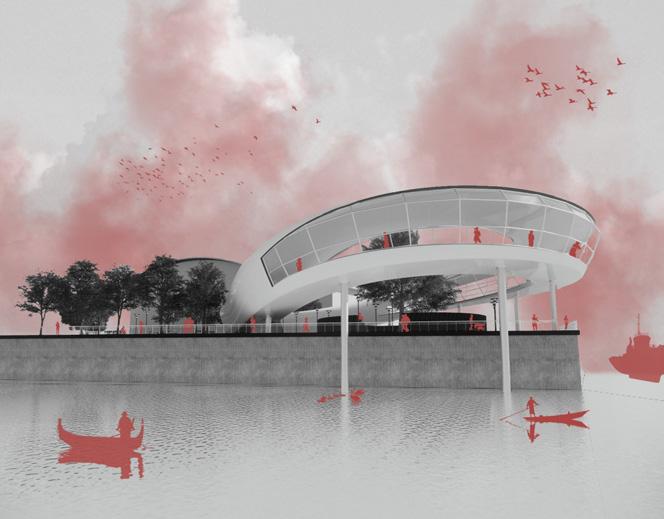
18.0170 N / 76.810 W 2020-2022 Selected Works /ARCHITECTURE PORTFOLIO
Nicholas Andrew Richards
My most significant memories generally surround experiences with friends and family, but the constant variable is always the spaces in which they took place. Architecture is all around us, constantly switching between the main character and a background role. I believe that life is about creating moments, and architecture functions as the facilitator to experience them.
NICHOLAS
RICHARDS
INDEX 02 CATALYST 03 CHRYSALIS 04 OASIS 01 THEOS Page 01 Page 20 Page 32 Page 46
THEOS
Asheville, NC
Type: Museum of Theology
Year: Winter + Spring 2022
Duration: 20 Weeks
Toolset: Rhino, Grasshopper, V-Ray, Illustrator, Photoshop Capstone Senior Project
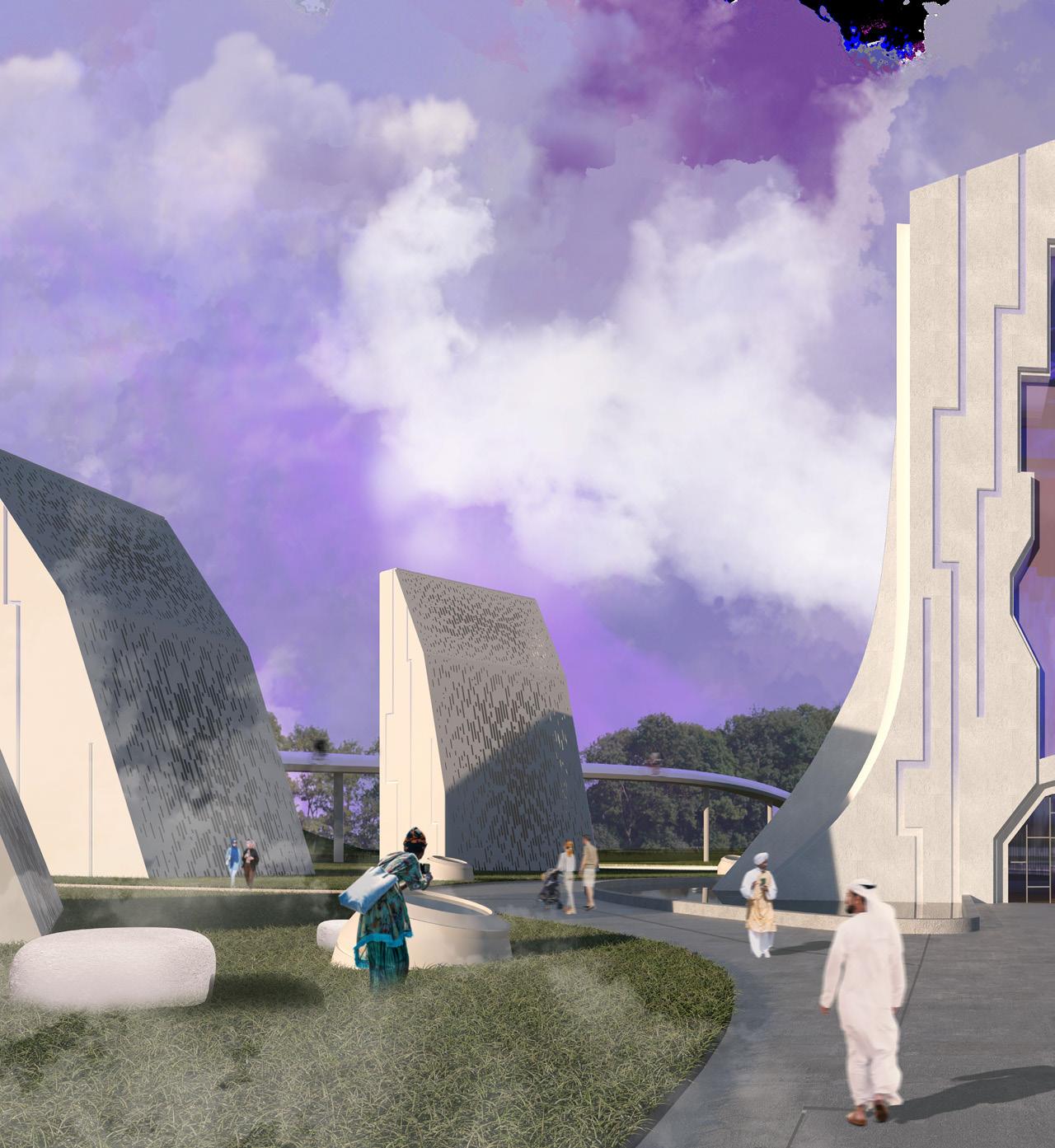
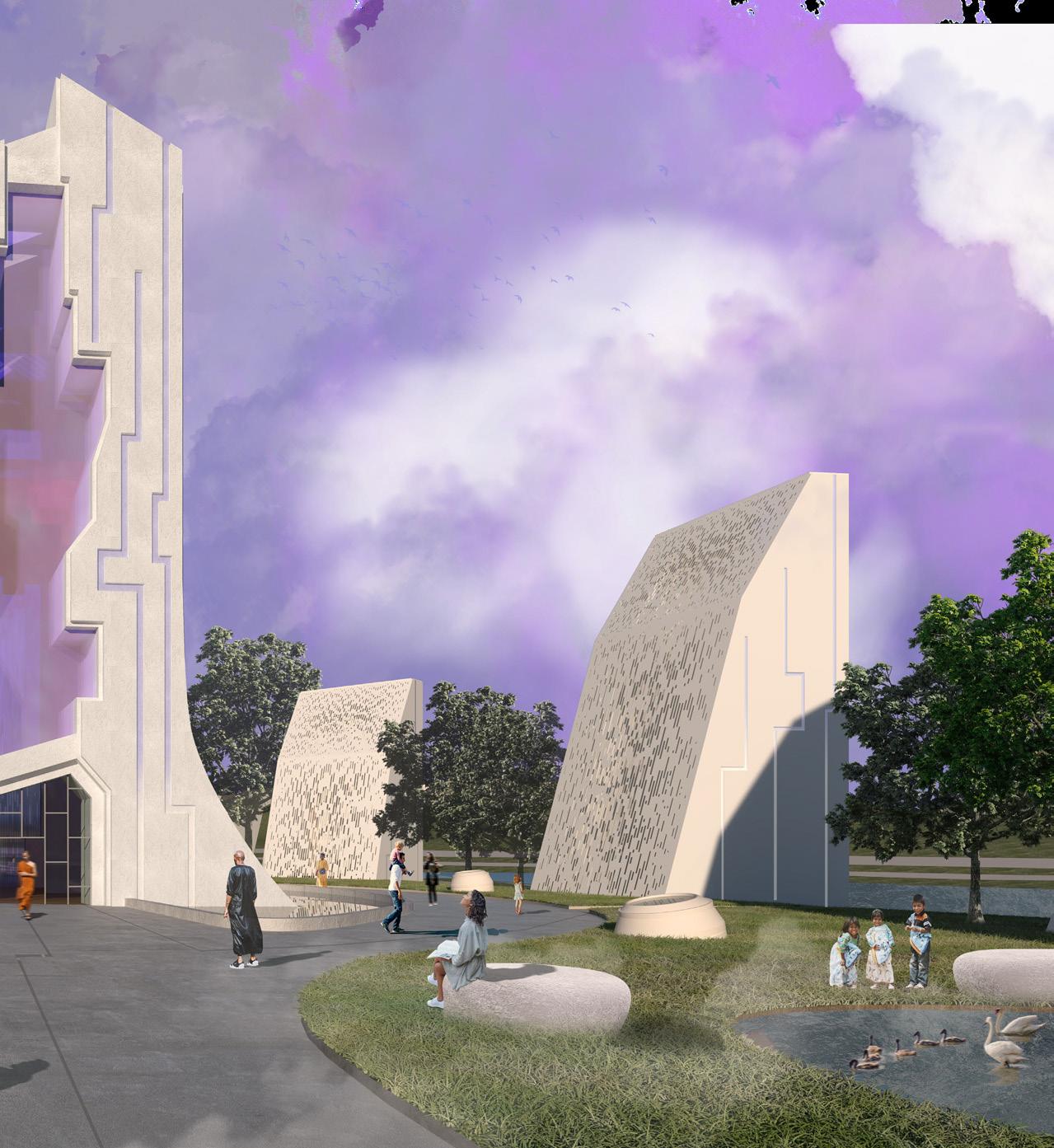
01 02
Museum of Theology
In a world clouded by social and environmental challenges, our generation has grown distant from one another As people, we all share contrasting backgrounds that differentiate us from one another, however, our values as humans are the same. Set in Asheville, North Carolina, Theos occupies 50,000 sq ft of the French Broad Park. This intervention minimally invades the natural aspects of the park by embedding most of the program below ground. As one approaches the museum, they are greeted by six (6) separate nodes surrounding a central structure that reveal themselves as being all connected when you enter the subterranean chambers. This parti reflects the notion that we all have diverging paths & beliefs, however, at our core, we are all connected through our humanity.
Asheville, North Carolina
Religion, in one form or another, has formed the core of human society for much of our history. It has an influence on everything around us, from the explanations we seek for our purpose within to the higher power behind the things we believe in. I believe architecture acts as a bridge to this paradigm due to its historical nature in society as a connector of people. The purpose of this museum is to challenge people’s perspectives by exhibiting diverging human heritage. By creating spaces that celebrate these similarities & differences, this experience aims to unify people of all backgrounds.
N E S W ASHEVILLE
35.5951° N, 82.5515° W N Parti Growth Fracture
THEOS
MUSEUM 03
|
Form Development
THE SITE
Located in the French Broad River Park, Theos occupies a central region on the site, maximizing the flat terrain.


ELEMENTAL AXIS

SUBTERRANEAN
Above ground, the park is transformed into a spiritual vessel. Below ground, the users experience an enlightening journey through perspectives of life.
CARVING
Natural elements carved the shape of the stones along with removal of dirt to create the programmatic space & pathways.
 Ancient stones aligned with the soltices & equinoxes emerged on the site.
Ancient stones aligned with the soltices & equinoxes emerged on the site.
04
The building form draws inspiration from natural elements and ancient civilizations. By aligning each node with the equinoxes, solstices, and lunar phases, the project is built on an axis for this spiritual center. Each external node has a monolithic design with perforated metal panels that diffuse light into the space.


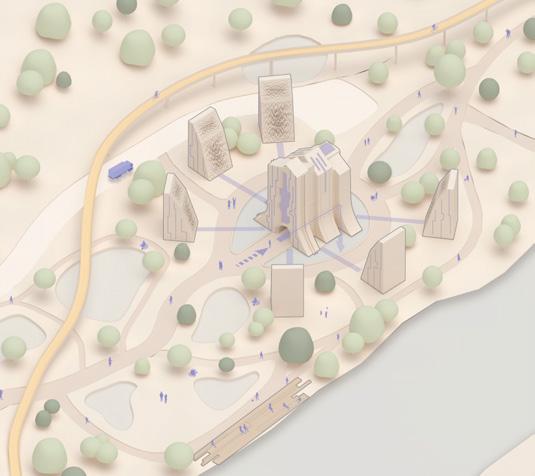

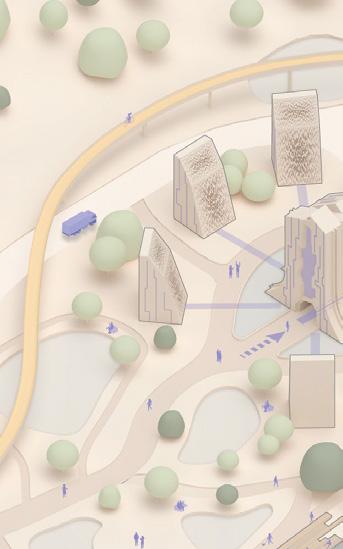
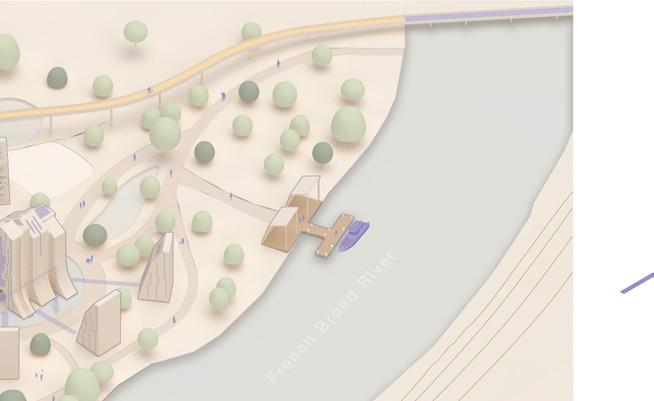
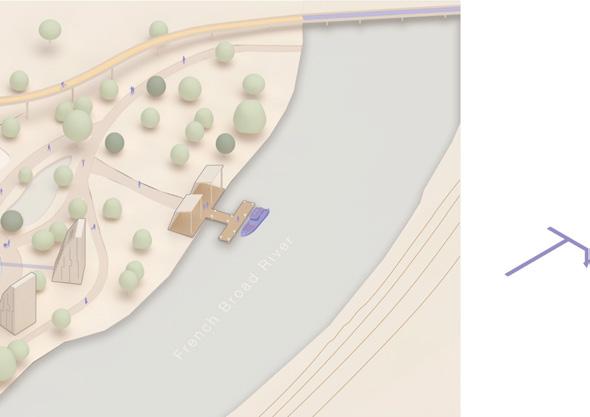
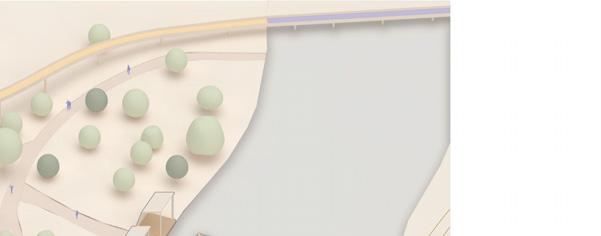

Pedestrian Bridge across the French Broad River Autonomous Boat Dock
Religious sculpture garden Light Wells
Perforated Metal Panels Modular skylight units allow disperse into the underground galleries.
Diffuse light throughout the ungrground nodes Skylight Unit
Egress Node Water Treatment Node
Site Development
05
The central building features a layered exterior that cur ves into the ground to give the appearance that it connects to something further. Through developing an underground program, the natural daylight of the chambers is controlled to create an immersive, yet sensitive experience for visitors of the museum.
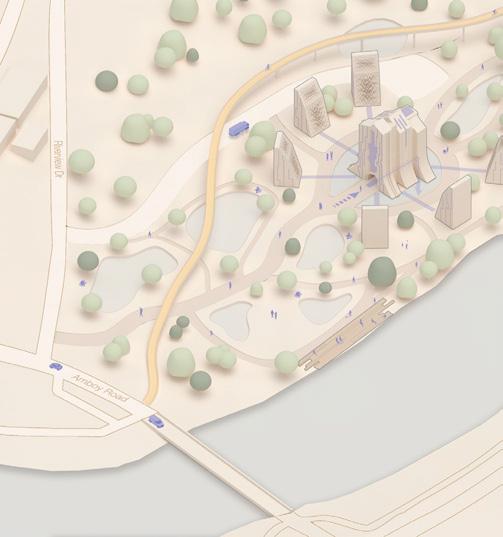

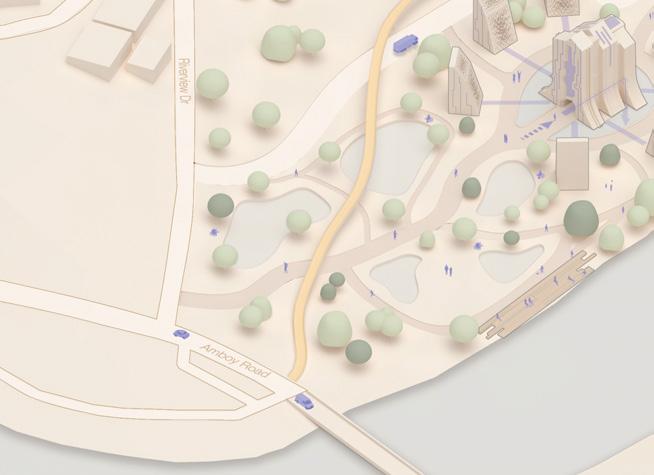
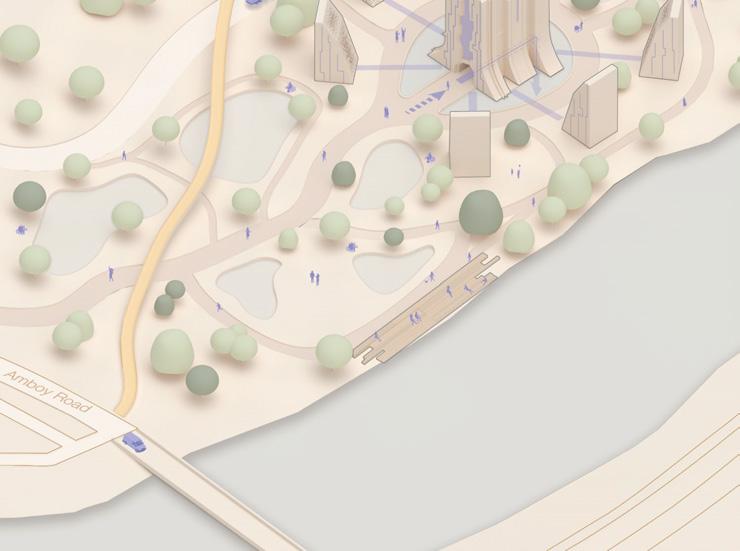
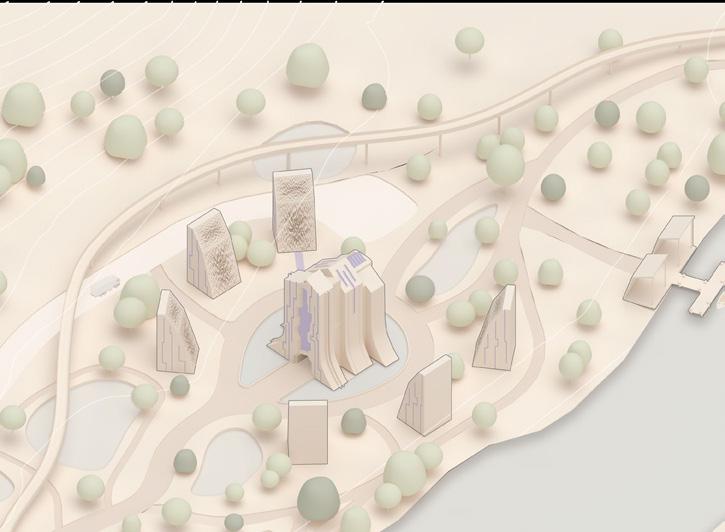
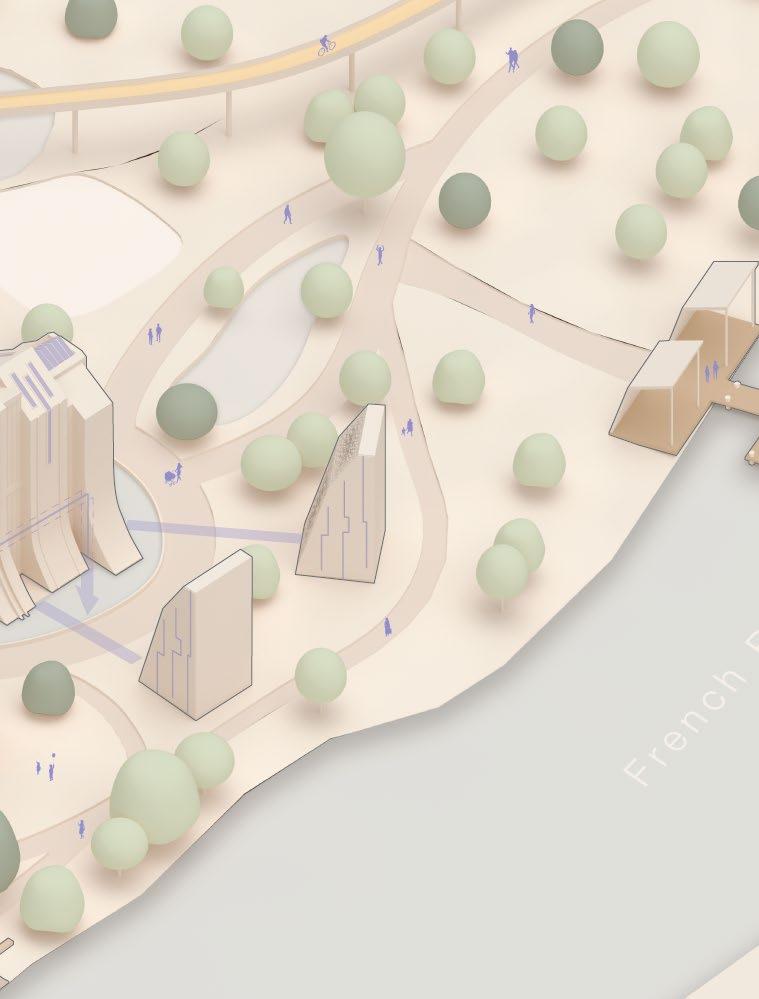
Shaded polycarbonate panels PV Panels Flexible Node Geothermal Node Service Node Elevated Bike Path Spiritual
Terraced
Transforms the existng bike path into a new elevated path that captures aerial views of the site along with connects to the new pedestrian bridge.
pools (retention ponds)
River Seating
06
Bioswales & Retention Ponds
Water collection bodies are selectively distributed throughout the site to collect surface runoff and rain water. This reduces chances of flooding and collects stormwater which is filtered in the respective node on site.
Topo Manipulation
Increase the flood plain by utilizing the soil from the underground cut to raise the topography.

Installed along the French Broad River bank to harness the hydropower. The generated power will be directed to the autonomous boat dock which contains the hub of the network.
Micro Water Power Generator
Pietzoelectric Floor Plate














IV
Horizontal Geothermal System
Site Master Plan

The central lobby of the museum features pietzoelectric floor panels which convert kinetic energy to electrical current. These are installed in the lobby as it hosts the most foot traffic.
The museums underground program utilizes the earth as a heat source/sink through its horizontal loop geothermal system.
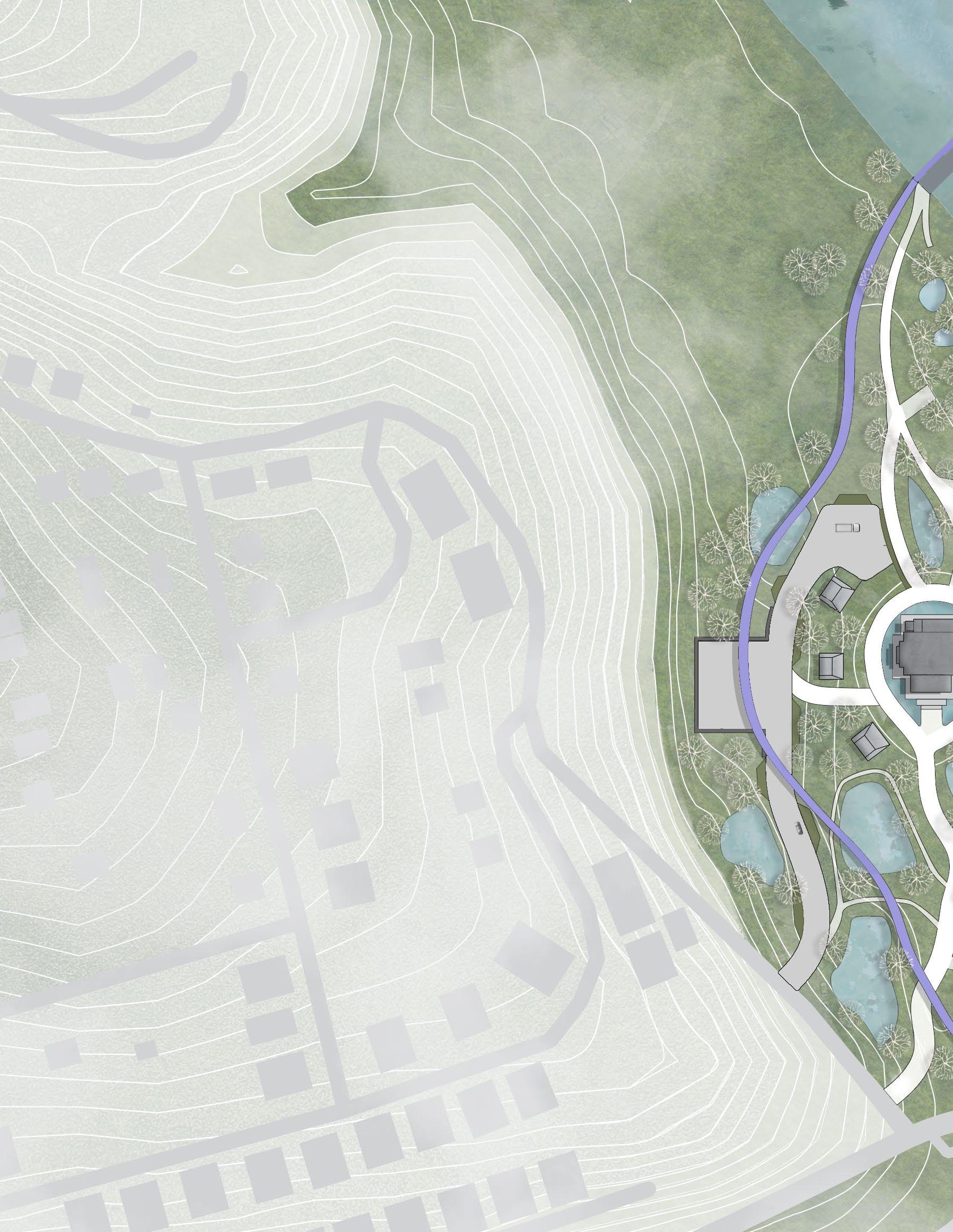
I II III IV
1982 1984 1986 III I 07
Mass Transportation Connection
The intervention on the French Broad Park integrates an autonomous boat project to expand in Asheville. This initiative aims to create a mass transportation system along the French Broad River.

FRENCH BROAD RIVER N 100 200 400 1” = 200’ 0
II IV 08
Ground Floor Plan Program N 0 20 40 80 1” = 40’ Above grade 1 2 4 5 6 7 8 9 10 3 1 2 3 4 5 6 7 8 9 10 Museum atrium - lobby Male Restroom Female Restroom Geothermal Node Egress Node Light well Node Water Treatment Node Egress Node Service Node Egress Stairs 09
Underground Floor Plan N 0 20 40 80 1” = 40’
grade 11 12 13 14 15 16 17 18 19 20 21 Gallery I Gallery II Skylight Cafe Conversation Pit Gallery III Gallery IV Gallery VI Neutral Space Conversation Pit Auditorium Neutral Scared Atrium 11 12 13 14 15 16 17 18 19 21 20 10
Below





Perspective Section Geothermal Horizontal Grade Translucent Dome Gallery Wall Rigid Insulation Reinforced Concrete Walking Path Detail Moisture Barier Grade Filter Drainage Layer Moisture Barrier Rigid Insulation Operable Fixture System Skylight Detail Double T-Column Detail Structural Details 11
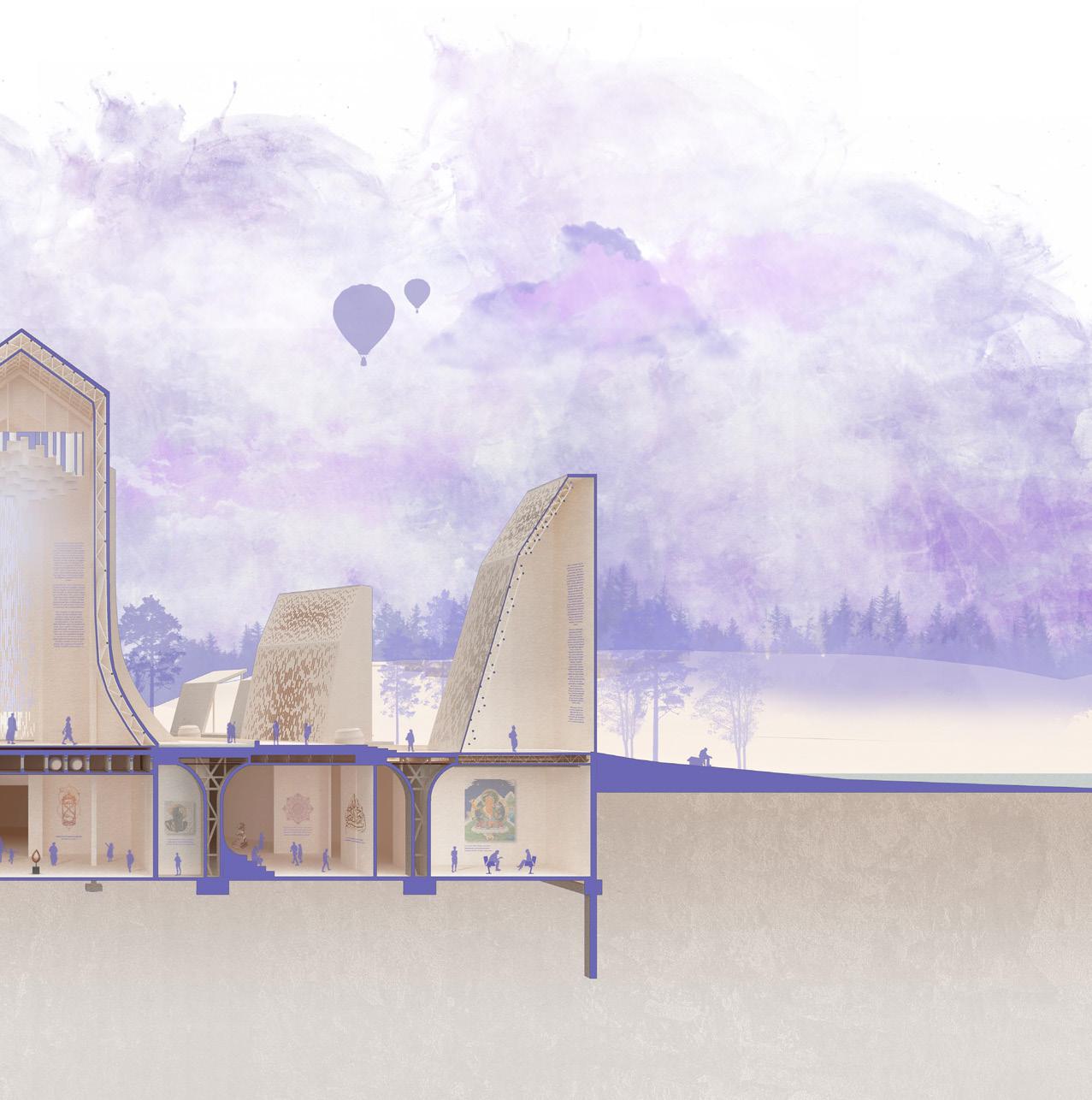



20 40 80 1” = 40’ 0 Horizontal System All artwork for the museum is transported through the 2 service elevator docks in the service node Venetian plaster on top Stone floor finish Reinforced concrete footer with steel column attached Drainage Layer Spaceframe System T-column Detail Segmented Metal Studs 1/4” Gypsum Board Featured Seating Raised Floor System Footer Detail Perforated Metal Screen Vapor Barrier Rigid Insulation Service Elevator Rigid Insulation Composite Deck Bar Joists Hat Channels Node Connection Detail Double T-column creates featured seating spaces and amplifies the natural ligght diffused through the skylight 12
Central Atrium
The programmatic layout of Theos is curated to create interactions with people and generate a conversation amongst users. Entering the central node is the main entry point into the underground chambers. A grand stairway leads people down different paths, depending on which direction they turn.

13
Museum Gallery
Each path hosts r eligious gallery spaces that overlap, merging cultures and traditions into seamlessly transitioning halls of art. Conversation pits and interactive regions are spread throughout the floor plan and users are eventually funneled into a central atrium. This large open space hosts a gallery-style space that has temporary exhibits showcasing work that creates a conversation amongst different user groups.

14
Node Detail
Structural Layout
Each node utilizes steel space frame systems to support the open space within along with their angular forms. The main underground space functions as a green roof due to the park’s amenities sitting above on grade. As such heavy steel framing is utilized throughout the project integrated with custom T-columns and truss systems in the open atrium space.
 Perforated Metal Panel
Raised floor system
Foundation Wall with footer
Engraved Glass reinforced conrete cladding Spaceframe System
Perforated Metal Panel
Raised floor system
Foundation Wall with footer
Engraved Glass reinforced conrete cladding Spaceframe System
15






Foundation walls & Columns Hybrid beam & truss system Spaceframe node structures 16
North Charleston, SC CATALYST
Type: (Adaptive Re-use) Tech Hub + Offices

Year: Fall 2021
Duration: 10 Weeks
Toolset: Revit, Rhino, Grasshopper, Enscape, Illustrator, Photoshop
ACSA 2022 COTE Competition
Submission
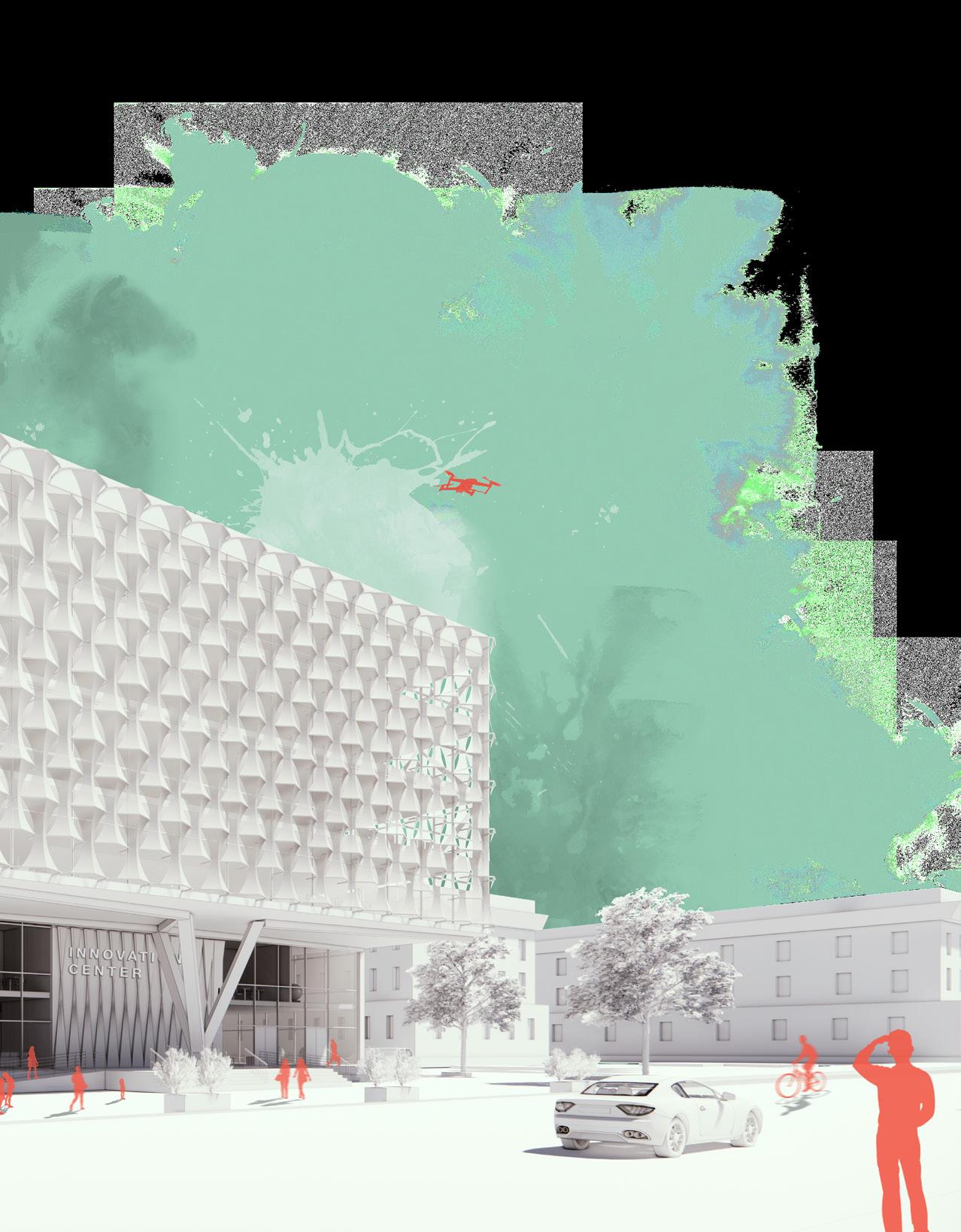
02 18
CATALYST Technological Innovation Center
Located in the Historic Navy Yard of North Charleston, this existing monolithic, brutalist structure was once a pioneer of its time but has now become a relic of the past. The concept behind this adaptive reuse project is to revitalize the initial purpose of the engineering management building as a catalyst of innovation.This project aims to be a renaissance of a symbolic building, introducing a new vernacular that ties into the existing form and function.
Thr ough civic and architectural intervention, this building will be transformed into an Innovation Center to function as an activator for industry growth in the area. The creation of a tech hub + educational center serves to invite future developers to see the potential in North Charleston as an advancing region.
North Charleston, South Carolina
Address existing site conditions Adaptive intervention








The existing monolithic concrete building set a strong foundation for reinterpreting its form by introducing new vernacular

55% of the existing structure was removed to allow the new vernacular to intervene the site and juxtapose the old style with the new.
The building footprint was expanded to create a more prominent street presence and curate an inviting public ground floor.




N Noisette Blvd N Hobson Ave Turnbull Ave N C A H D E G F B Innovation Center Tech Hub Start-up Offices Program: +
Expansion
Footprint
Legend A. Pedestrian Pathway E. Ponds B. Bike Racks F. Parking C. Basketball Court G. Courtyard D. Picnic Pods H. Adjacent Building Site Plan 20 40 80 1” = 40’ Rainwater Harvesting Wall Energy Recovery Ventilator Renovated Park Carbon absorbtion algae wall Stack Ventilation Atrium 19
Eight inclusive “digital cities”

Expanding Opportunity from emerging innovation clusters US Cities that employ more women and mninority populations in tech. In these cities, people of color, women and workers without a college degree are receiving more jobs than the sector norm. The goal of this project is to make Charleston the ninth.
Charleston is one of the fastest growing tech markets in the country. Due to the rapid increase of new residents moving in each day, the city is rapidly evolving to meet the needs of its citizens. The area has quietly developed into the number 1 mid-sized U.S metro area for IT job growth.
Sacramento Denver St. Louis Columbus Washington D.C Raleigh Charleston Greenville Pittsburgh Austin Boston Chicago Dallas Los Angeles New York San Diego San Francisco Thriving Seattle Berkeley Nascent Carlsbad Emerging Dover Pasadena Redwood City Fort Worth Scaling Newport Beach Raleigh San Antonio Santa Clara Orlando Plane Charleston Fort Lauderdale Kansas City Omaha Providence
First Floor Plan Second Floor Plan Third Floor Plan Program Office Levels 41. Focus Labs 40. Private Offices 39. Specialist Zone 38. Presentation Room 37. Enclosed Terrace 36. Office Pods 35. Co-working hub Innovation Center 34. Outdoor Terrace 33. Mechanical Room 32. Tech Lab 31. Industrial Lab 30. Server Room 29. Atrium 28. Testing Lab 27. Virtual Reality Hub 26. Recreational Zone 25. Cafe 24. Studios 23. Event Seating 22. Gallery 21. Tech Lab 20. Communal Lounge 19. Material Library 18. Storage 17. Egress Stairs 16. Gender Neutral Restroom 15. Female Restroom 14. Energy Recovery Ventilation Core 13. Male Restroom 12. Rainwater Filtration System 11. Service Room 10. Conference Room 9. Computer Lab 8. Tech Lab 7. Model Shop 6. Fabrication Lab 5. Print Room 4. Lobby 3. Classrooms 2. Lounge 1. Entry 20
Design for Integration Design for Ecosystems Design for Resources

Structure flex ETFE panel systems are utilized to shade the curtain walls and diffuse light throughout the space. The central atrium functions as a stack ventilation system, creating an airflow between floors. The high thermal mass of the revitalized concrete structure contributes to the reduced heat load within the 200,000 square foot structure. Occupants will be in the comfort zone 32% of the year, with passive shading and thermal mass heating dictating the other 68%.
As an adaptive reuse project, 52% of the existing concrete structure was revitalized in the new design. 5819 metric tons of embodied CO2 will be captured through the reuse of this material. The concrete panels that were removed will be recycled at local plants. Lastly, carbon emissions will be reduced through the passive algae modular panels.
The Egress wall of the south panels that contain algae. algae are approximately removing carbon from carbon reduction sets a introducing these modular within the area.
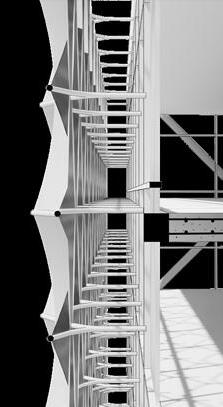
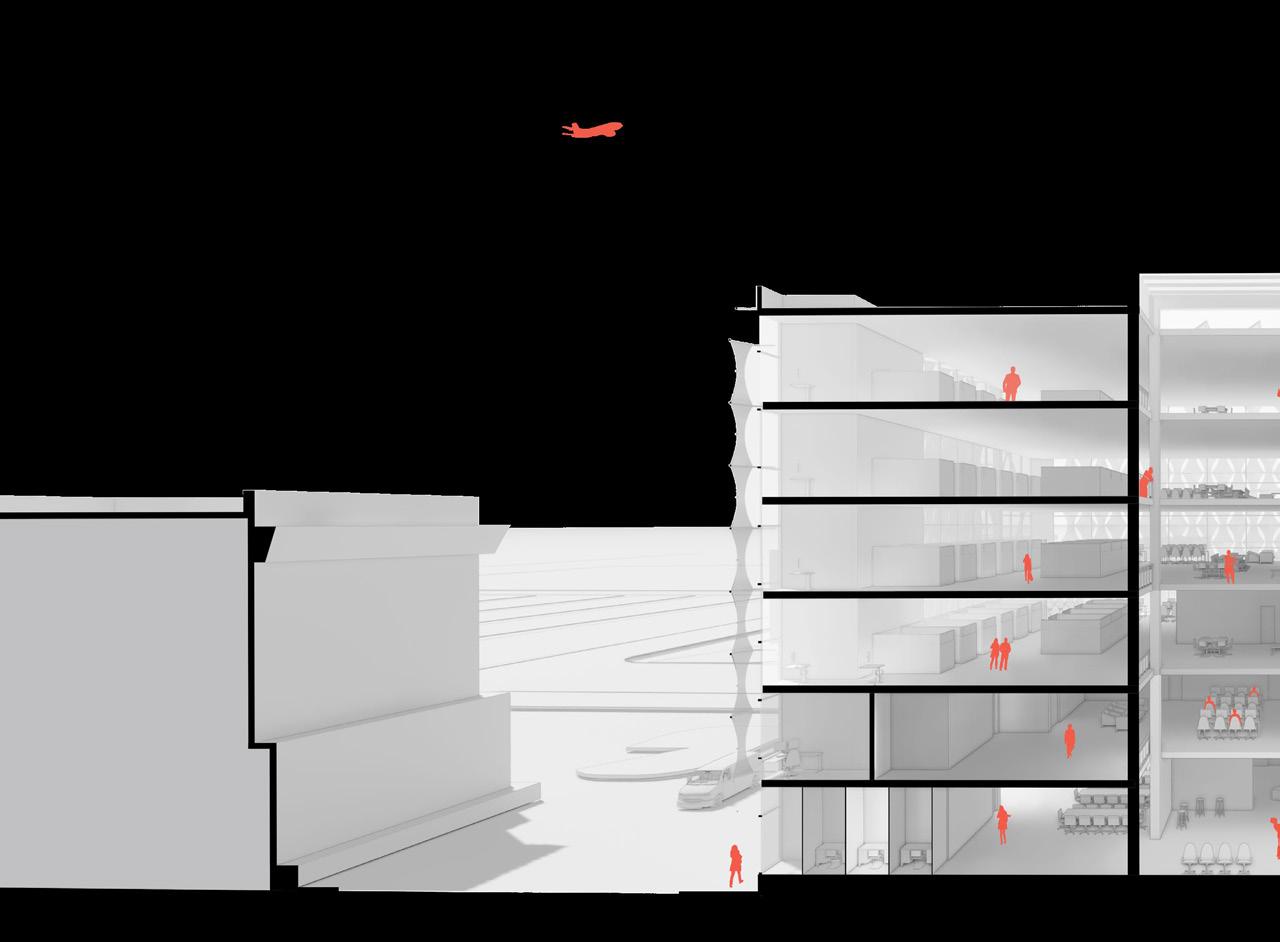
Double Envelope Detail


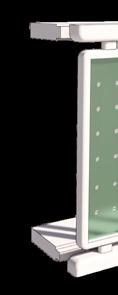
Office Office Pods Co-working Computer Private Pod Study Rooms Dry Bulb Temp (C °) Humidity Ratio (gm water/ gm of Dry Air) -10-5 0 -5 0 5 10 15 20 25 30 35 05101520 20 40 60 80 25303540455055 0.000 0.005 0.010 0.015 0.020 0.030 0.025 100 120 140
Lateral Section
The ETFE shading panels are projected from the facade of the building, creating a double envelope system that is attached to the curtain walls with steel framing.
21
Ecosystems Design for Discovery Design for Economy





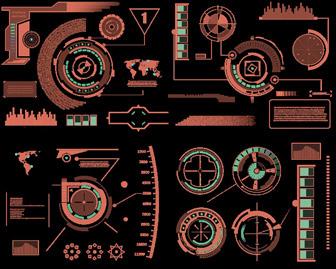



south facade features modular algae. Comparative to trees, microapproximately 150 to 200 times more efficient at the air. This response to embodied a foundation to expand upon by modular panels into upcoming projects

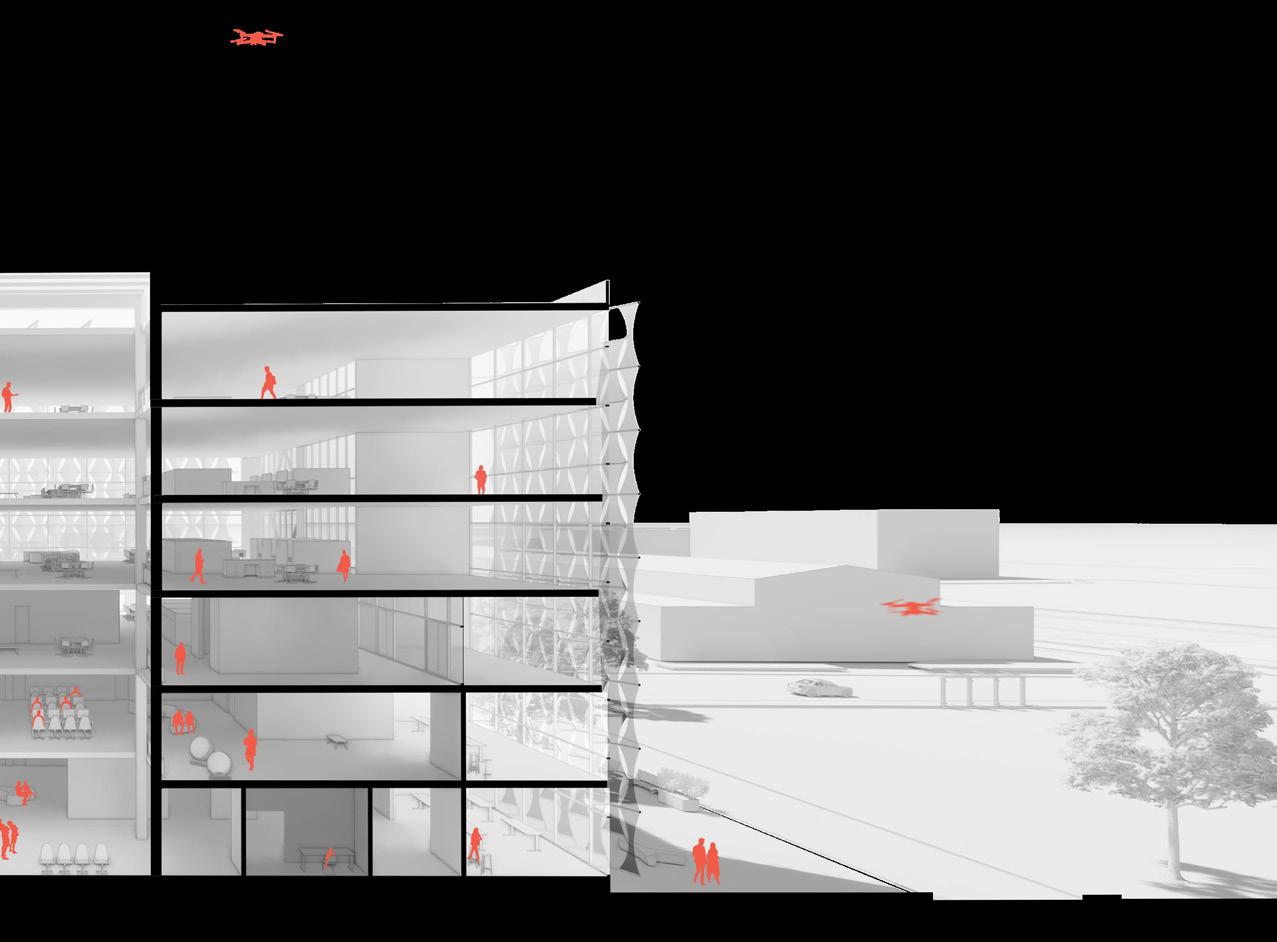
The implemented sustainable systems will be tracked based on performance and these metrics will be visualized on holographic boards in the central atrium. The Catalyst is designed as a symbol of innovation, as such, the program is designed to continuously evolve with the advancements in technology. Each sustainable system has the potential to be further advanced through developments in design.
The Catalyst’s program aims to be an economic driver for the city of Charleston. Due to the rapidly developing tech industry, the job market for computer scientists is at its peak. By introducing tech classes and industrial workshops, the public sector will have the opportunity to learn previously unattainable skillsets such as programming. Start-up businesses that occupy the office levels will also introduce new careers to the market. This will increase job mobility in the region and in turn have a positive effect on Charleston’s economy.

Lounge
Co-working Hub Computer Labs Tech Lab Cistern Cistern 1,095,100 Watts 2333 PV Panels 5819 Metric Tons 0 20 40 1” = 20’ 80
Model Shop
22
Exisiting Building Adaptation
In adapting an exisiting building, the goal of this project was to honor the original design and blend the existing facade with modern architectural elements. The building itself is a representation of innovation as the existing facade is juxataposed by the new materiality, showcasing the progression in the area and of the current generation.
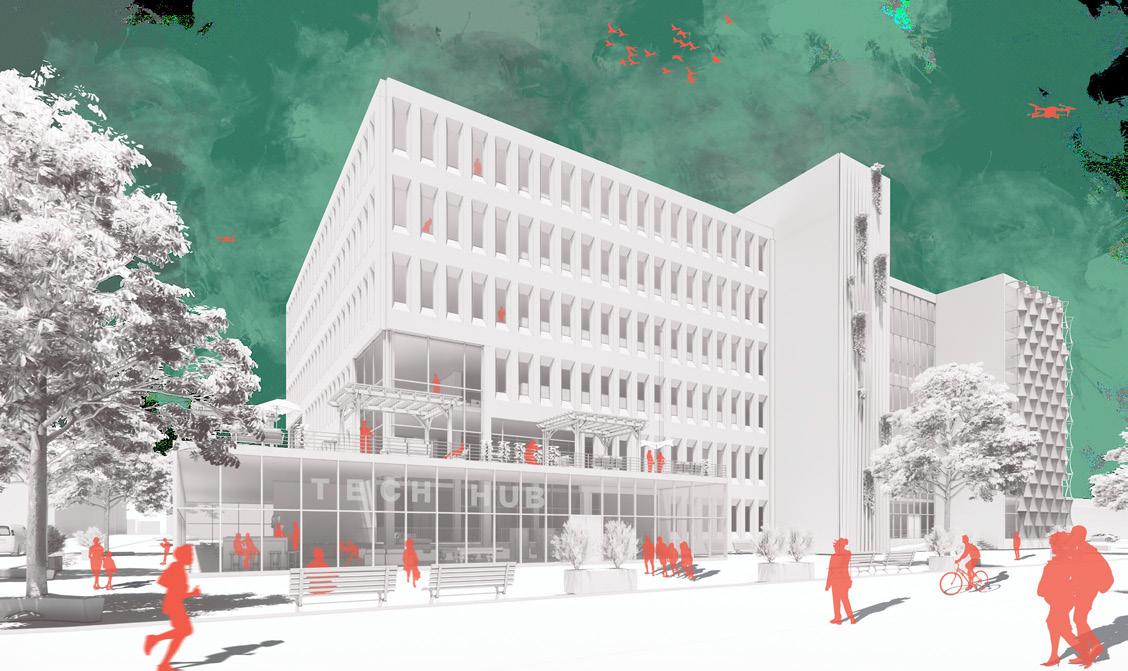
23
Central Atrium
The central atrium functions as the technological hub of the Catalyst and allows natural sunlight to filter throughout the western wing. Heat generated from the technological systems within the building filter through the atrium and into the mechanical core where it is captured by the EPV system.
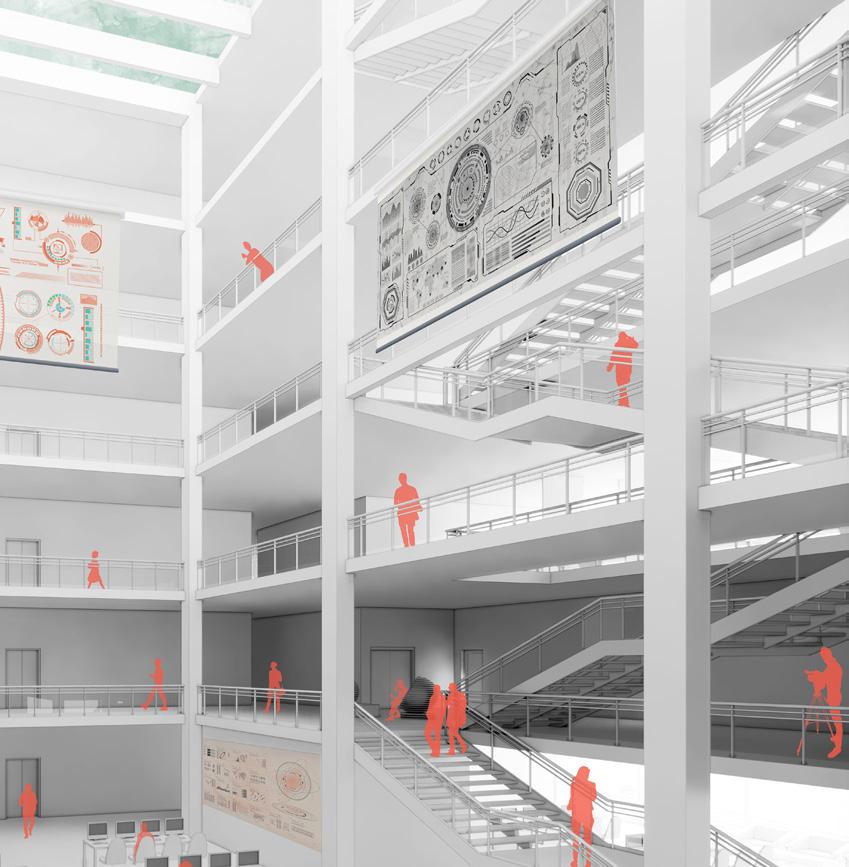
24
Design for Integration Design for Energy Design for Water


The juxtaposition of the existing structure with a new addition conveys the idea of this innovation center serving as a catalyst for developing the tech industry in Charleston. Through capitalizing on the rapid growth of the area, the building’s contrasting facades represent this emergence of a new digital city as a response to the community and changing times.
Capitalizing on the site’s climatic conditions, capturing solar energy and heat gain functioned as the driving sustainable system in this project. South facing PV arrays are fixed to the roof of the building and a heat diffusing facade system wraps the curtain walls.The core of the building features energy recovery ventilation systems that can recover 70% to 80% of the energy in the exiting air of a building and deliver that energy to the incoming air. Additionally, the Algae wall on the south facade reduces carbon emissions through the species intense photosynthetic abilities.
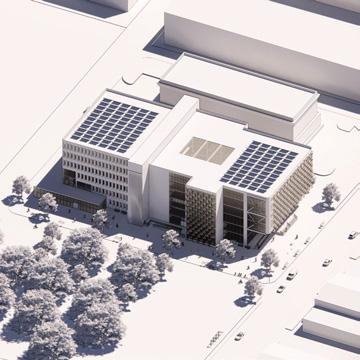
The north facade of the building made of water harvesting rainwater from the roof down be stored in cisterns beneath is held for re-use and pumped system located behind the Energy
The ventilation in the the of heat
Passive system - Daylight and Stack Ventilation Atrium


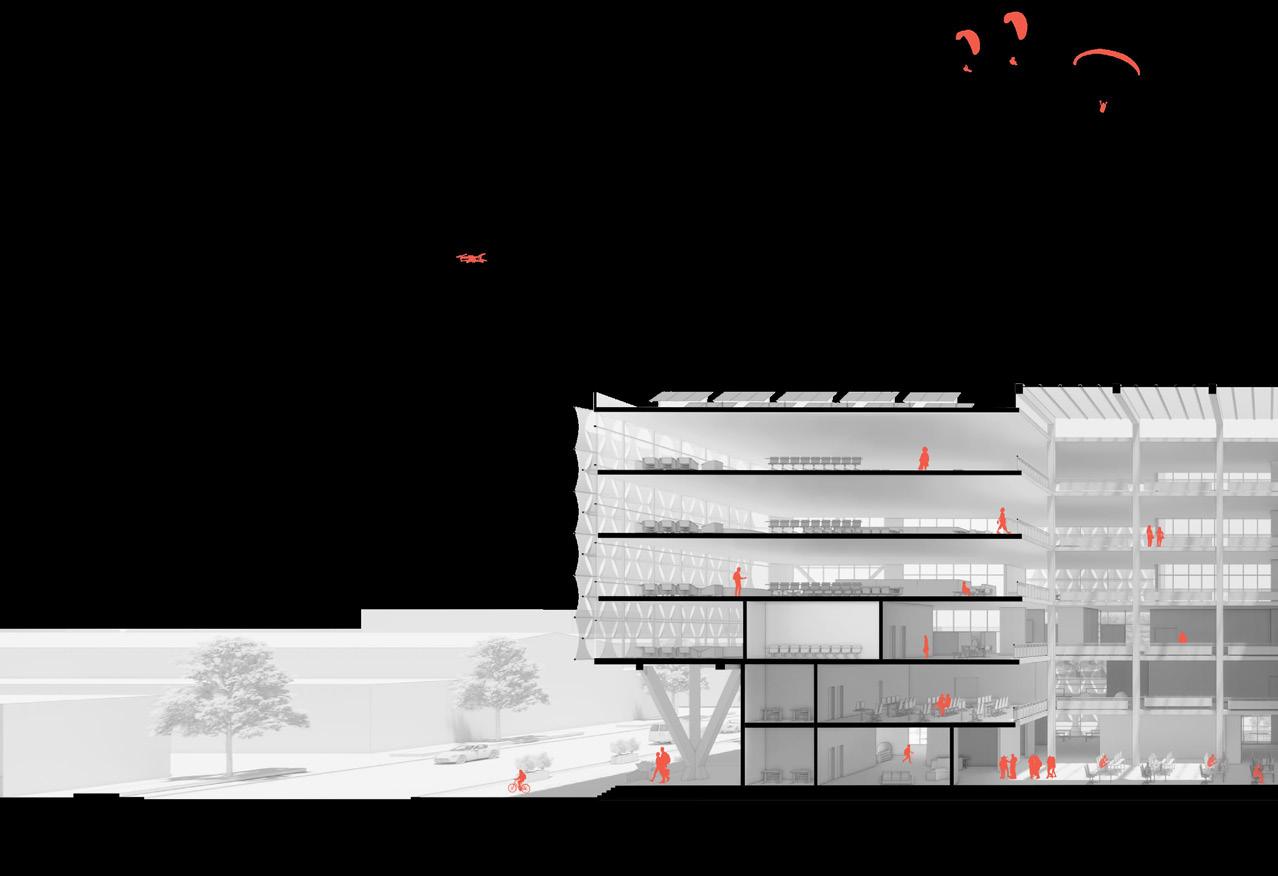
Direct sunlight is filtered through the central atrium of the building, diffusing light throughout the west section of the structure. Air flows between this vertical corridor, filtering into the EPV system.
Entrance Overhang - Shading & Office Exposure
The shaded overhanging entrance creates a prominent street presence that shades the west facade of the building and exposes the program of the innovation center, inviting the public to enter.
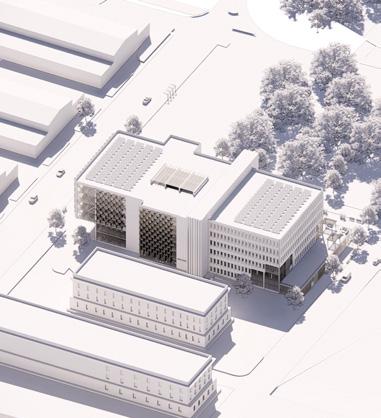
Longitudinal Section
25
Water building features a wall harvesting fins that channel down into the ground to beneath grade. This water pumped into the filtration the water fin wall.
Design for Equitable Community
The goal of this project was to introduce a tech innovation center into a growing digital city. The site is located in North Charleston within the historic navy yard which is primarily an industrial area. Through expanding the already existing tech industry in downtown Charleston to this sector, job mobility will increase and invite future development into the area. The educational aspect of the program will allow those are interested in the tech industry but have not had prior access to learn about this field.
Energy Recovery Ventilation Core
The building’s central core features an Energy recovery ventilation HVAC system that exchanges the energy contained the exhausted air of the conditioned space, using it to treat the incoming outdoor ventilation air. This controls the high level heat produced by the technology in the building.

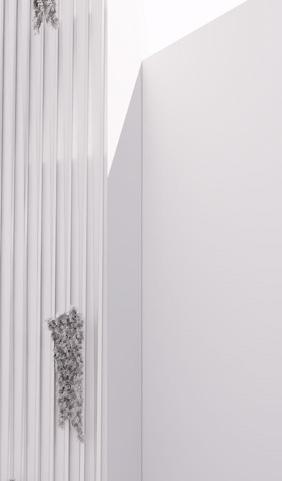
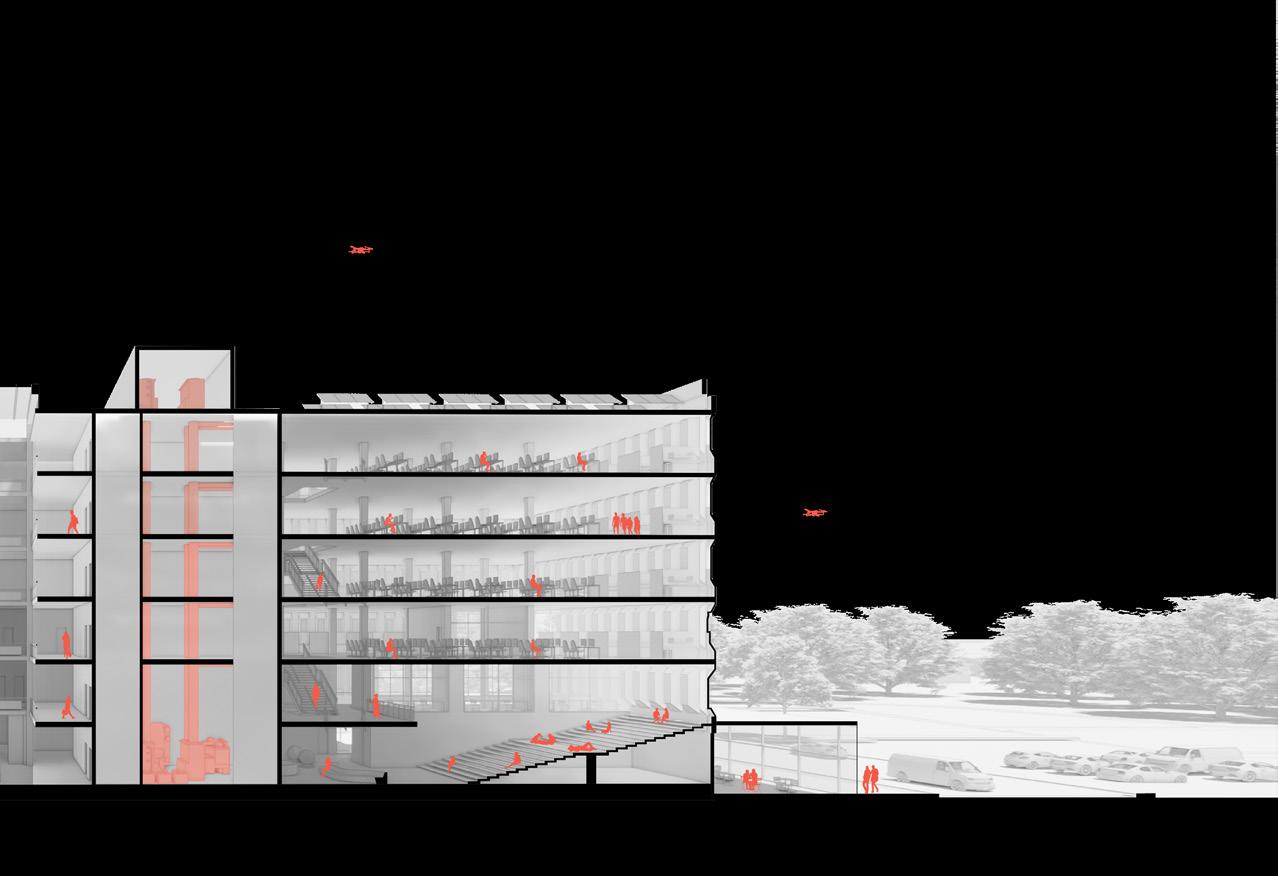
Design for Well-being






The building diffuses natural light throughout the interior spaces primarily through the central atrium, creating an comforting environment controlled by the ERV system. An outdoor terrace addition was introduced on the existing facade to engage the public domain and create a stronger connection the adjacent park which has been revitalized with new pathways and seating areas.

Active system - PV Panels

Approximately 11,000 sq ft of south facing PV panels are featured on the roof of the structure, generating solar power for the overall building.
Event seating + Outdoor Terrace
A double height feature stair seating area lies adjacent to the second level terrace on the east facade. These spaces provide breaking points between the intense working + learning activity of the building program.
0 20 40 80 1” = 20’
Leaseable Offices Tech Hub Innovation Center
26
North Easton, MA CHRYSALIS
Type: Event Pavilion (Mixed-use)

Year: Spring 2021
Duration: 10 Weeks
Toolset: Rhino, Grasshopper, Lumion, Illustrator, Photoshop, After Effects
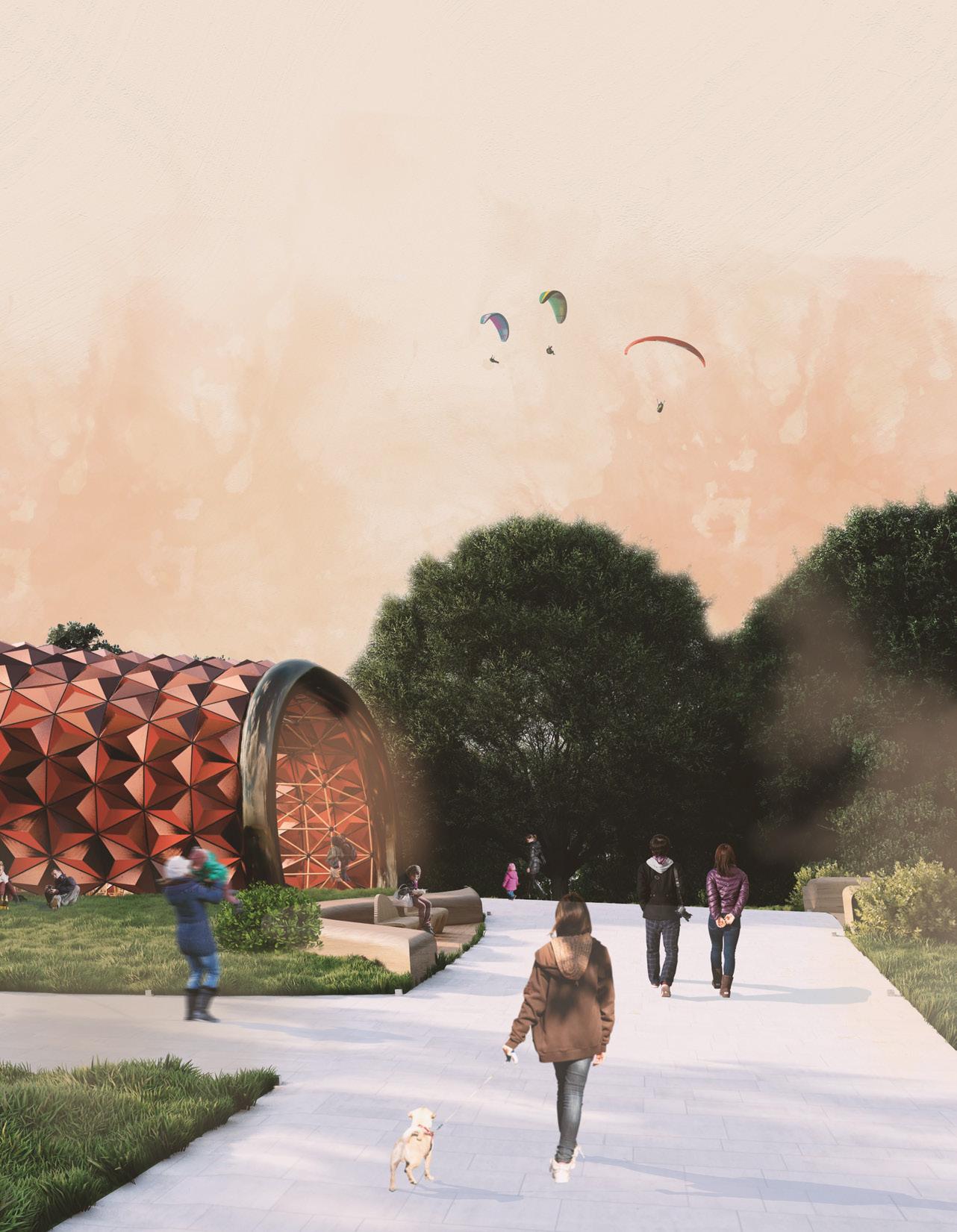
03 28
Interchangeable Event Space CHRYSALIS | PAVILION

Ar chitecture is constantly evolving much like the world around us. We live in a generation that adopts change, which is paramount by technological innovation. This idea of a paradigm shift that embraces transience in today’s society is the anchor of this project. By creating an event pavilion that features a flexible floor plan , space can be adjusted to suit the need of specific events, curating new environments with each layout.
The Chrysalis Pavilion is a symbol of change for people from all walks of life, sharing the roots of the existing Ames main house to express a new purpose. Through its dynamic form-changing facade, adaptation is expressed within the design, reflecting the multi-use space in both form and function. The facade features kinetic panels that open and close to adapt to climatic conditions and bridge the boundary between indoor and outdoor space.
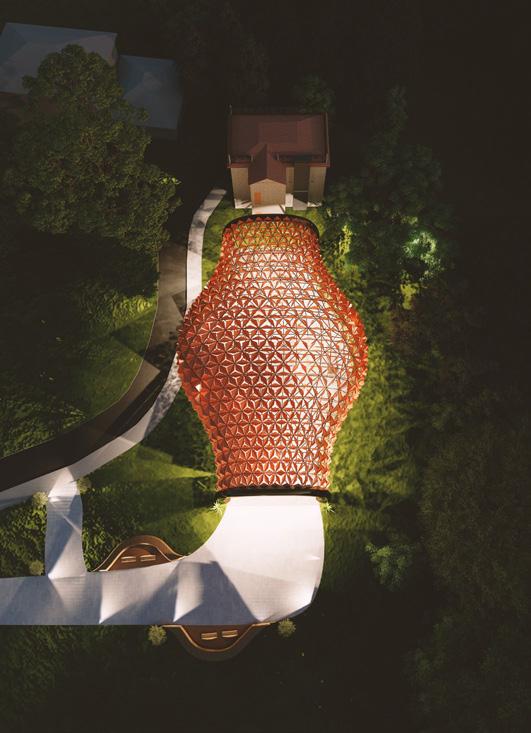 Legend
1. Interactive Educational Wall
2. ADA Entrance Path
3. Picnic Pads
4. Pavilion Outdoor Seating
5. Event Pavilion
6. Kinetic Pathway Pads
7. Tent Space
8. Multi-media Deck
9. Additional Parking
10. Cube House
Legend
1. Interactive Educational Wall
2. ADA Entrance Path
3. Picnic Pads
4. Pavilion Outdoor Seating
5. Event Pavilion
6. Kinetic Pathway Pads
7. Tent Space
8. Multi-media Deck
9. Additional Parking
10. Cube House
Plan
11. Carriage House
Site
N
Drone View
1 2 3 4 5 6 7 8 9 10 11 29
Sun path & angle - 8AM
Sun path & angle - 1PM


Sun path & angle - 6PM
Responsive Facade

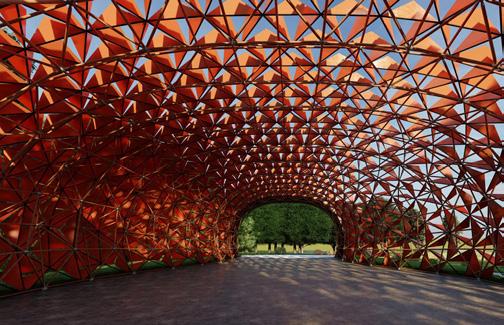

The kinetic panels have the ability to respond to the movement of the sun and control the lighting conditions throughout the day. Due to Massachussets’ temperate climate this feature is designed mainly to control lighting, however, in the event that the temperature is high, this solar paneling system also serves to reduce heat gain.
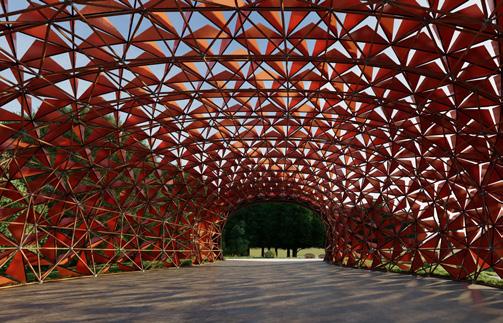 Chrysalis Lighting 6PM
Chrysalis Lighting 1PM
Chrysalis Lighting 8AM
Chrysalis Lighting 6PM
Chrysalis Lighting 1PM
Chrysalis Lighting 8AM
30
Chrysalis represents a transitional state, such as the stage between a caterpillar changing into a butterfly. The form of this pavilion pays homage to this principle as it expands at the center and contracts at the ends to create a dynamic space that ties back to the original concept.
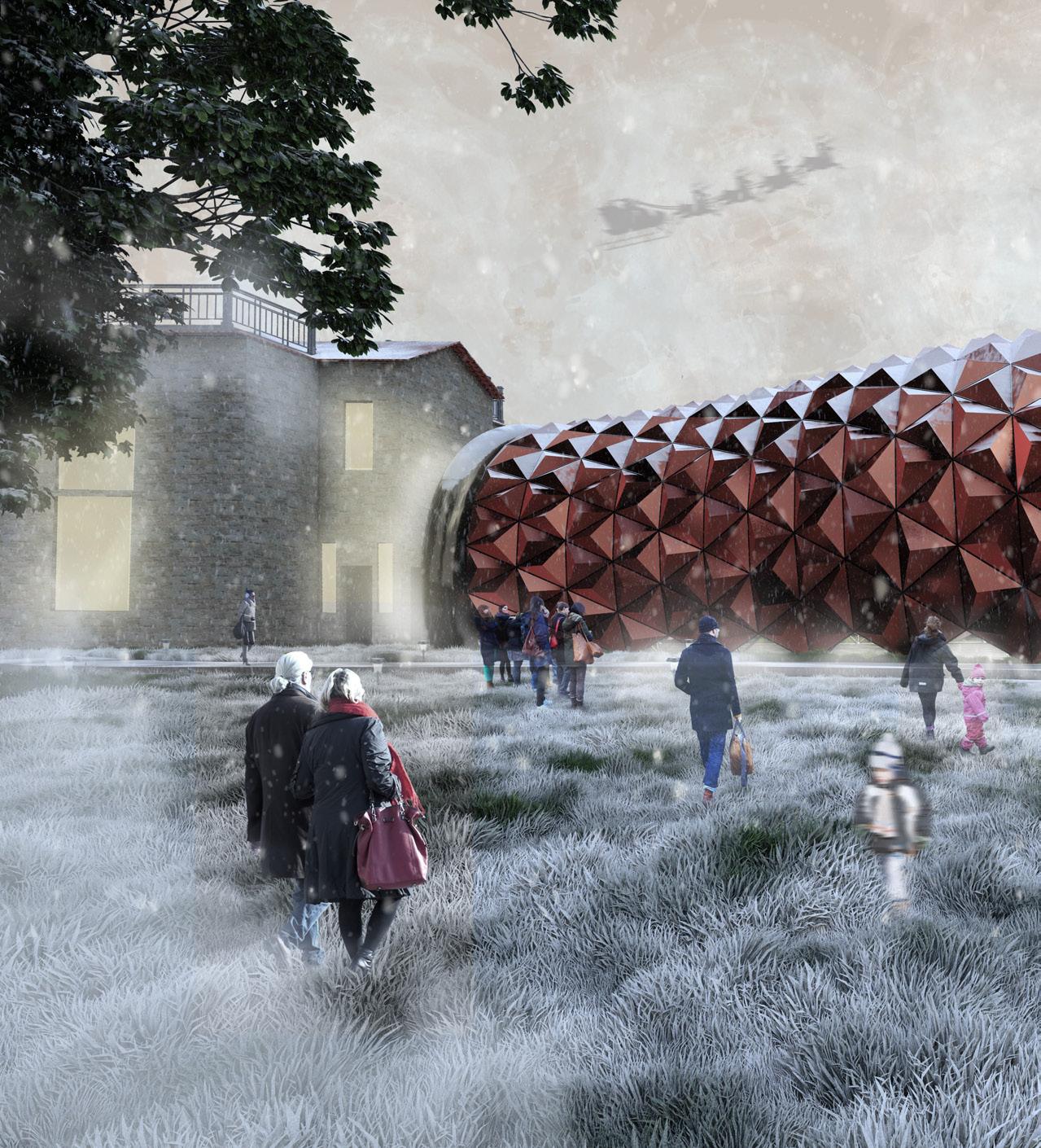

Winter View 32
Kinetic Facade

Panel Cells
Each panel node can rotate up to 50 0 individually or simultaneously
Panel
Framing System
Rotating Mechanism
This framing layer connects the panels to the spaceframe and hosts the rotary system.
Timber Spaceframe
Spaceframe Detail
Concrete Footers
The timber spaceframe nodes connect to one another to transport loads into the foundation.
Structural Development
Foundation Detail
A pin connection is used to attach the spaceframe to the foundation.
The Chrysalis consists of four (4) main structural components that come together to support its adaptable skin and ensure the structure transfers loads effectively.
33
Supporting Cube House
Event Pavilion Floor Plan
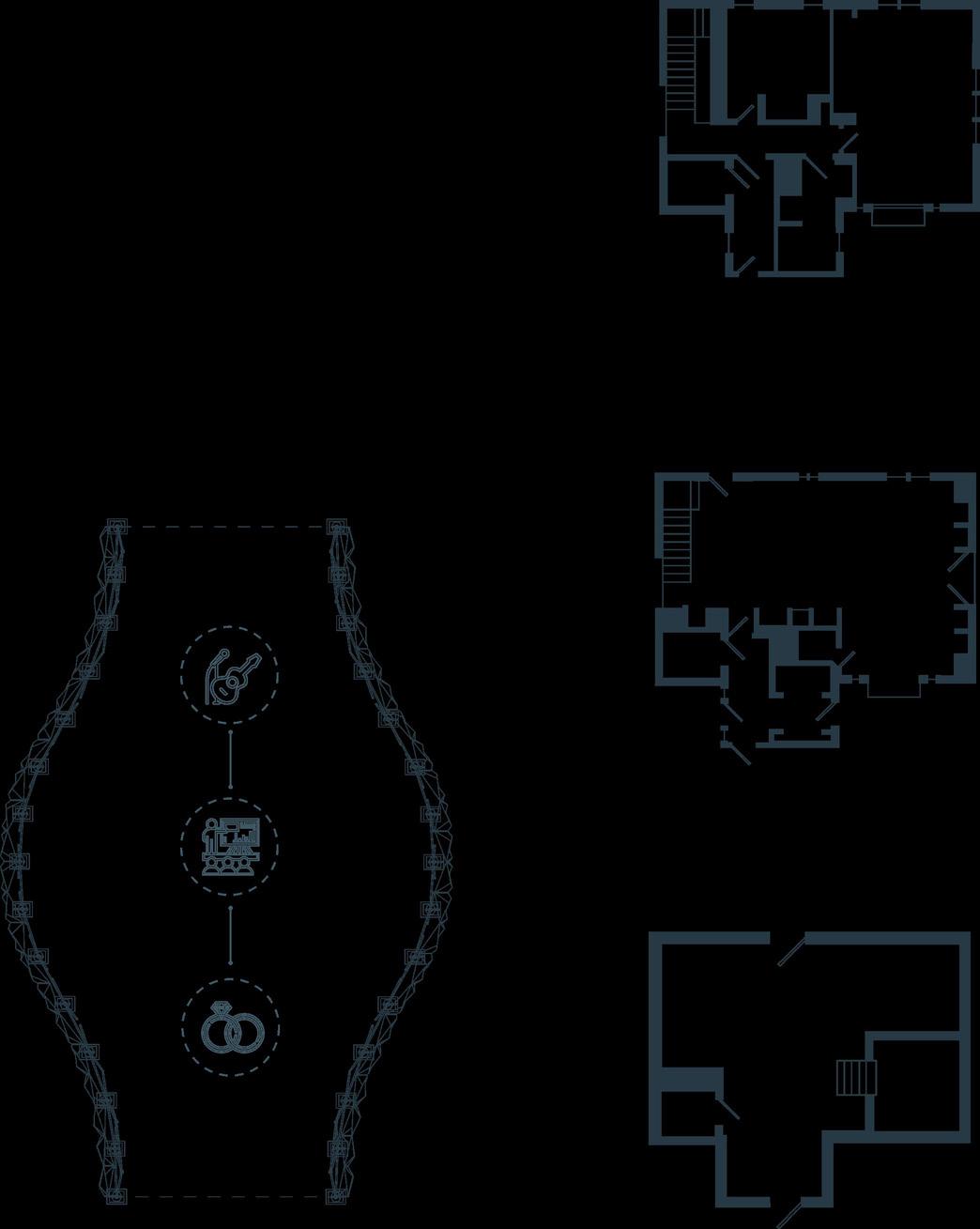
The floor plan of the Chrysalis is intended to be dynamic and flexible to host numerous event types from wedding receptions to live performances.

Second Floor
The second floor contains more storage and restrooms as well as a gallery showcasing the history of the Ames Estate.
The ground floor hosts the catering kitchen along with restrooms for the event pavilion.
Ground Floor Storage
Basement
The basement houses the majority of storage used in the pavilion as the requierments change depending on the event.
Chrysalis Pavilion
Storage
Kitchen Ames
Elevator Elevator Elevator Restroom Restroom Restroom Crawl
34
Catering
History & Interprative Space
Space
Wedding Reception
The Chr ysalis is the perfect place for a wedding reception with its large floor plan and unique lighting conditions created by the kinetic panels.
Piano Performance
By closing all the panels, pavilion are enchanced and express their talents
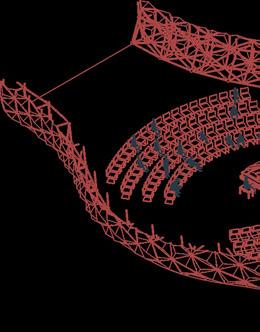
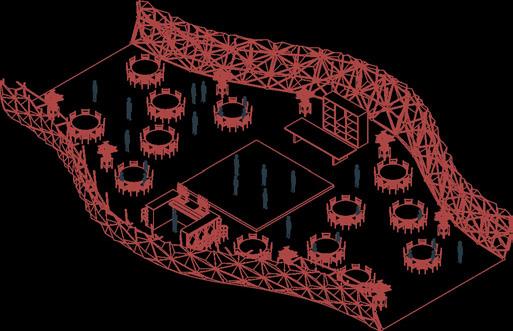

panels, the acoustics within the and set the stage for musicians to
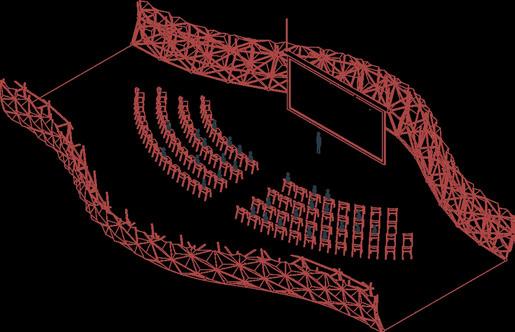


Educational Lecture
As this pavilion is open to both public and private events, this grand space can be used to host educational lectures about the Ames History, or reserved for a private screening event.
36
Thunderbolt,GA OASIS
Type: Environmental Awareness Park
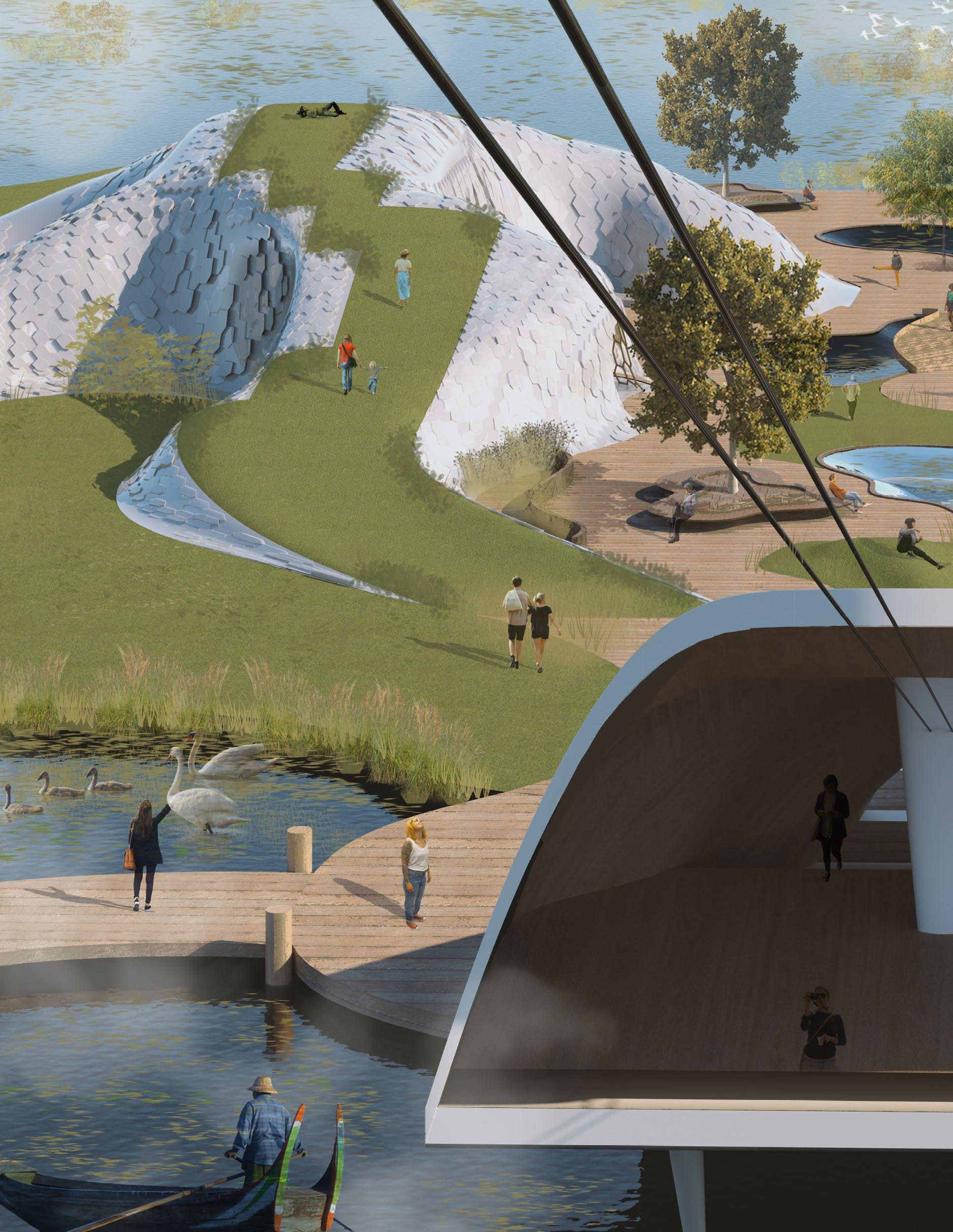
Year: Winter 2021
Duration: 10 Weeks
Toolset: Rhino, Grasshopper, V-ray, Illustrator, Photoshop
IDA 2021 Honorable Mention

04 38
OASIS
Environmental Awareness Park
Oasis is a place of serenity, isolated from the urban context. The purpose of this project is to educate individuals about the symbiotic relationship between mankind and the natural environment through a symbolic “Oasis”. This merger of architecture and landscape conveys a unique expression of how we coexist with the world around us.
The form appears as a manipulation of the landscape, implying that the structures emerged from the ground and were engineered to create programmatic space. This public park and restoration site is used to encourage community gatherings and spread local awareness on the pollution of the marshlands.
Conceptual Sketches
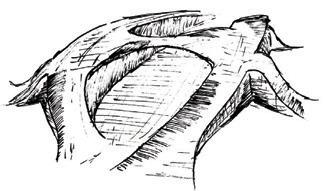
Thunderbolt
Wilmington River
Site Plan
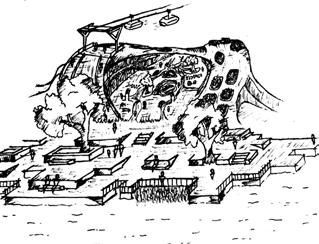
The site is located within the marshland of Thunderbolt, isolated from the urban environment. The Oasis is introduced to this ecosystem and creates a unique public space for individuals to gather and occupy the natural environment while being connected to the architecture.
 Oasis
Oasis
N 39
Gondola Station
Walkable Green Roof
The final element of Oasis hills are the two green roofs that slope down to the base of each structure, creating walkable paths for the visitors to interact with the site.
PTFE Ventilated Mesh

Coated in fiberglass, PTFE fiberglass ventilated panels cover the exterior of the facade, creating a durable skin that is waterproof and long lasting.
Translucent Membrane
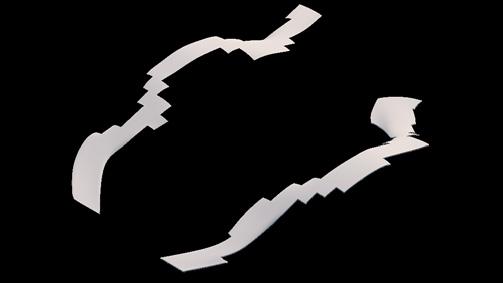

Wrapping the superstructure is a lightweight translucent membrane that allows light to penetrate the interior and supports the PTFE layer.
Hexagonal Cell Structure
A parametric structural space-frame is utilized to support the structure of the Oasis “hills” to allow the interior spaces to be open and free of columns.
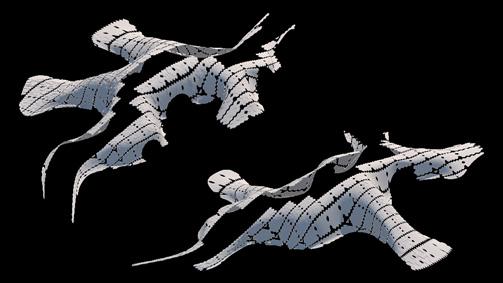
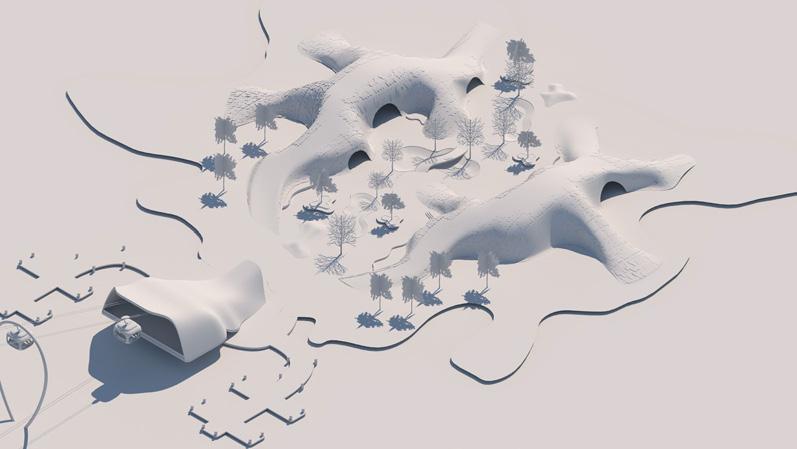
Structural Axonometric Diagram
40
Cable Support Structure
The Gondola line is supported by a series of undulating tower structures that are arnchored to the river bed. These curved elements host the cables that carry the gondolas across the river.
Gondola Pod
To access the Oasis, visitors travel across the Wilmington River using gondola pods designed to capture the unique experience of the site. The open design allows users to embrace the natural beauty of the surrounding area.
Gondola Station
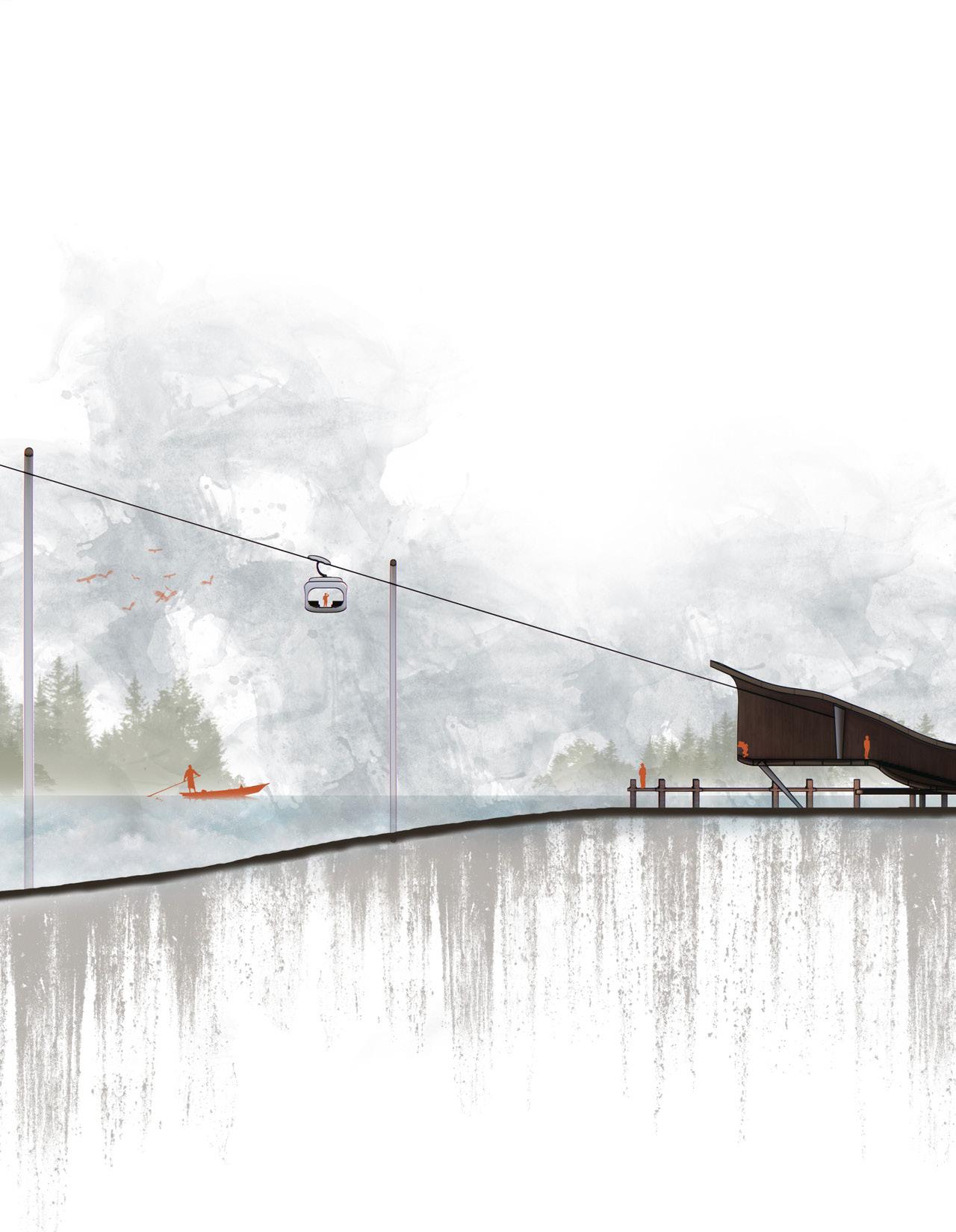
Visitors arrive at the Oasis Gondola Station and to allow exiting guests to board. These gondola stations are located at various parks around the introducing a new mode of transportation between public spaces.
Wilmington River
41
and unload
gondola the city, between
Marshland Park
The Oasis creates a natural environmental public park within the marsh that serves as a restoration site for the surrounding species.
Walkable Green Roof
The Oasis features walkable green roofs on both of the emerging structures. These allow visitors to view the surrounding area from a new perspective in a site that is predominantly flat.
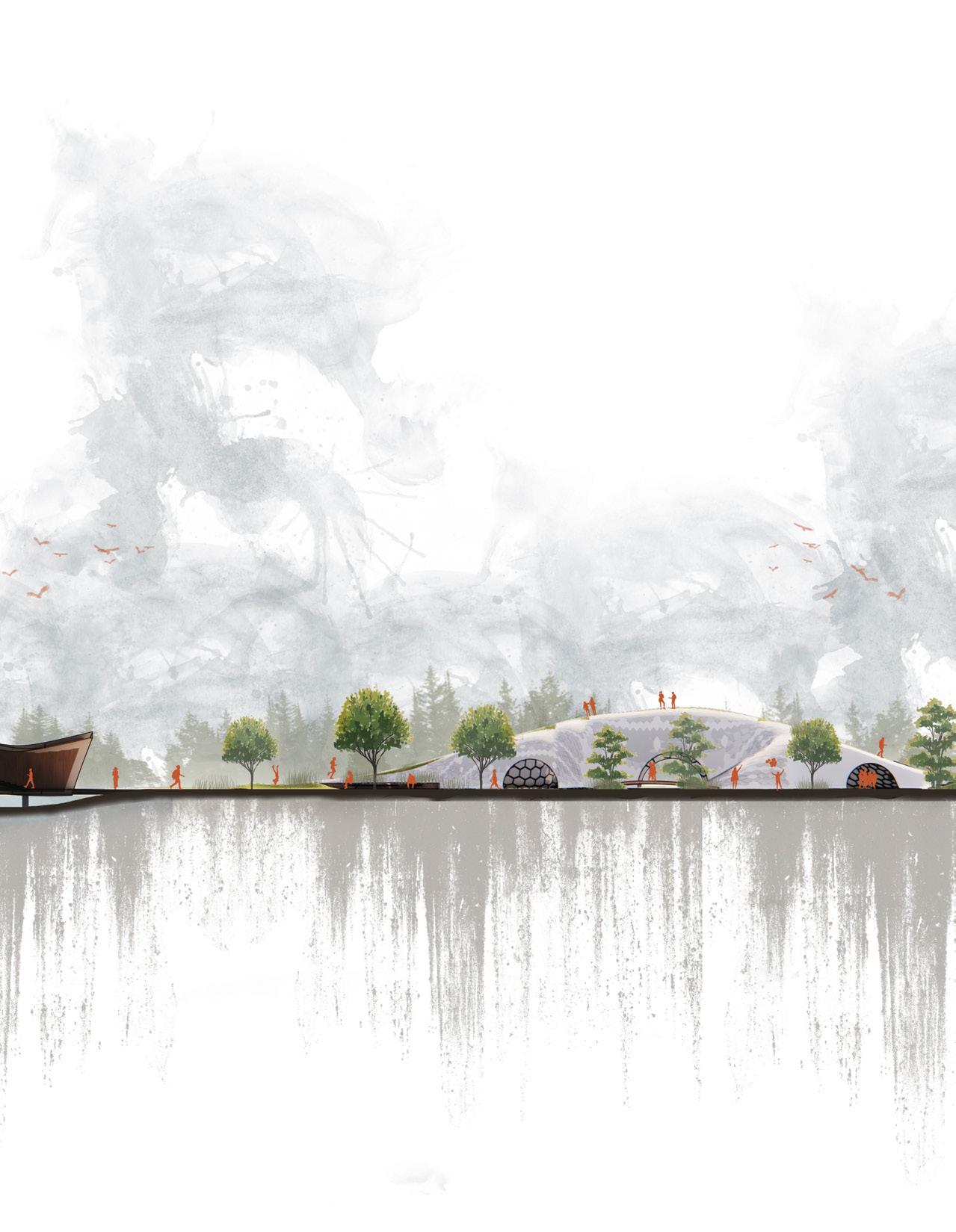
| Site Section | 42
Dock Entrance |
The undulating forms of the pr oject juxtaposes the architectural vernacular of the area, however, these hill-like structures purposefully stand out in a rather flat-lying area. By creating a form that conveys itself as a manipulation of the landscape, the Oasis breaks the boundaries between the built and natural environment by combining them into one. The project is separated into two forms with a grand courtyard that connects them. Each form features walkable green roofs that encourage visitors to ambulate and capture new perspectives of the beautiful marshlands surrounding the site.

|
43
Spartina Grass Farming Hub |
The Oasis houses Spartina grass planting pods that gr ow native plants used to create buffer strips of healthy plants that resist diseases and filter the marshlands. As the Oasis is open to the public, the planting pods are accessible by anyone, and users are encouraged to aid in the restoration process by harvesting healthy plants and building buffer strips as a communal activity. This allows the community to become a part of the resiliency in their own local ecosystem and become more connected to their environment.
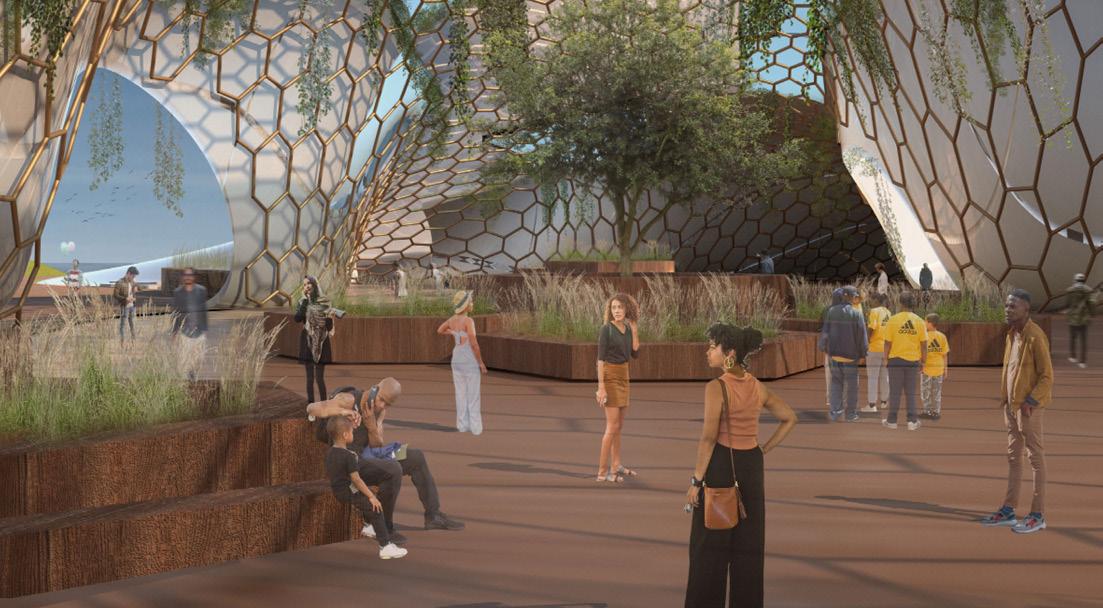
|
44
Oasis Floor Plan

City-wide Gondola Project
Through expansion of the Oasis Gondola Transportation System, the cities of Savannah and Thunderbolt can utilize the success of this development to create a network of gondola systems that connect the city’s major parks and squares. The City-wide Gondola Project aims to provide a new perspective on public transportation and bring new life into the city as it provides a unique experience in traveling.

N 45
Physical Model Photographs

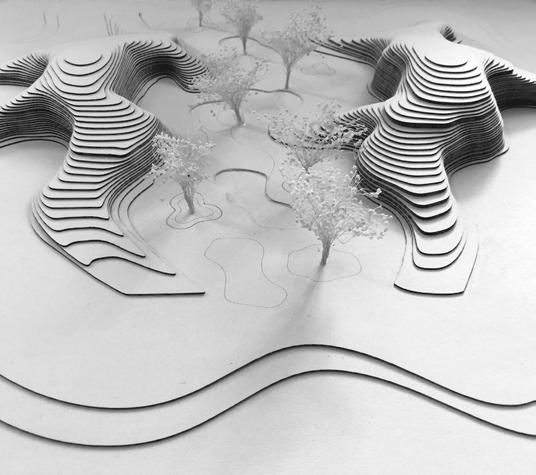
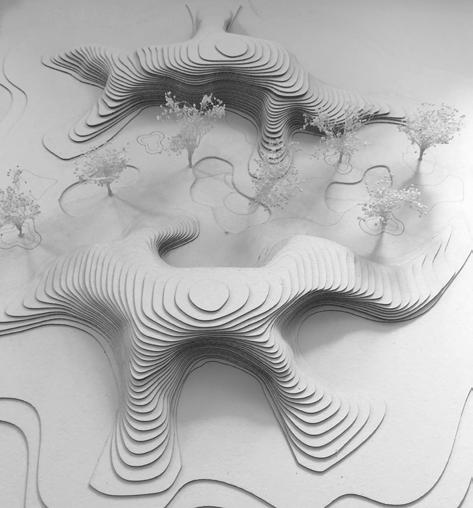

46
“ Life is about creating moments, and architecture functions as a facilitator to experience them”

18.017 0 N / 76.81 0 W







 Ancient stones aligned with the soltices & equinoxes emerged on the site.
Ancient stones aligned with the soltices & equinoxes emerged on the site.



























 Perforated Metal Panel
Raised floor system
Foundation Wall with footer
Engraved Glass reinforced conrete cladding Spaceframe System
Perforated Metal Panel
Raised floor system
Foundation Wall with footer
Engraved Glass reinforced conrete cladding Spaceframe System















































 Legend
1. Interactive Educational Wall
2. ADA Entrance Path
3. Picnic Pads
4. Pavilion Outdoor Seating
5. Event Pavilion
6. Kinetic Pathway Pads
7. Tent Space
8. Multi-media Deck
9. Additional Parking
10. Cube House
Legend
1. Interactive Educational Wall
2. ADA Entrance Path
3. Picnic Pads
4. Pavilion Outdoor Seating
5. Event Pavilion
6. Kinetic Pathway Pads
7. Tent Space
8. Multi-media Deck
9. Additional Parking
10. Cube House





 Chrysalis Lighting 6PM
Chrysalis Lighting 1PM
Chrysalis Lighting 8AM
Chrysalis Lighting 6PM
Chrysalis Lighting 1PM
Chrysalis Lighting 8AM















 Oasis
Oasis















